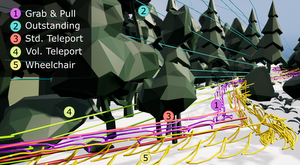Information
- Publication Type: Conference Paper
- Workgroup(s)/Project(s):
- Date: 2025
- ISBN: 978-989-758-728-3
- Publisher: SciTePress
- Location: Porto
- Lecturer: Marlene Huber
- Event: 20th International Joint Conference on Computer Vision, Imaging and Computer Graphics Theory and Applications
- Booktitle: Proceedings of the 20th International Joint Conference on Computer Vision, Imaging and Computer Graphics Theory and Applications - GRAPP
- Pages: 13
- Volume: 1
- Conference date: 26. February 2025 – 28. February 2025
- Pages: 161 – 173
- Keywords: Virtual Reality, Accessibility, Locomotion, User Study
Abstract
Virtual reality (VR) is often designed as a standing experience, excluding individuals with limited mobility. Given that a significant portion of the population experiences lower-body mobility restrictions, accessible VR locomotion must accommodate users without requiring lower-body movement. To build a comprehensive understanding of suitable locomotion techniques (LTs) for this demographic, it is crucial to evaluate the feasibility of various approaches in virtual environments (VEs). As a starting point, we present our evaluation approach and a user study on the feasibility and potential of selected LTs for accessible seated locomotion in VR. Our findings indicate that common LTs can be adapted for seated stationary VR. Teleportation-based techniques, in particular, stand out as viable options for accessible locomotion. Although our simulated wheelchair was less popular with non-disabled participants, it was well-received by wheelchair users and shows promise as an intuitive LT for (More)Additional Files and Images
Weblinks
BibTeX
@inproceedings{huber-2025-esl,
title = "Exploring Seated Locomotion Techniques in Virtual Reality
for People with Limited Mobility",
author = "Marlene Huber and Simon Kloiber and Annalena Ulschmid and
Agata Marta Soccini and Alessandro Clocchiatti and Hannes
Kaufmann and Katharina Kr\"{o}sl",
year = "2025",
abstract = "Virtual reality (VR) is often designed as a standing
experience, excluding individuals with limited mobility.
Given that a significant portion of the population
experiences lower-body mobility restrictions, accessible VR
locomotion must accommodate users without requiring
lower-body movement. To build a comprehensive understanding
of suitable locomotion techniques (LTs) for this
demographic, it is crucial to evaluate the feasibility of
various approaches in virtual environments (VEs). As a
starting point, we present our evaluation approach and a
user study on the feasibility and potential of selected LTs
for accessible seated locomotion in VR. Our findings
indicate that common LTs can be adapted for seated
stationary VR. Teleportation-based techniques, in
particular, stand out as viable options for accessible
locomotion. Although our simulated wheelchair was less
popular with non-disabled participants, it was well-received
by wheelchair users and shows promise as an intuitive LT for
(More)",
isbn = "978-989-758-728-3",
publisher = "SciTePress",
location = "Porto",
event = "20th International Joint Conference on Computer Vision,
Imaging and Computer Graphics Theory and Applications",
booktitle = "Proceedings of the 20th International Joint Conference on
Computer Vision, Imaging and Computer Graphics Theory and
Applications - GRAPP",
pages = "13",
volume = "1",
pages = "161--173",
keywords = "Virtual Reality, Accessibility, Locomotion, User Study",
URL = "https://www.cg.tuwien.ac.at/research/publications/2025/huber-2025-esl/",
}


 image
image paper
paper
